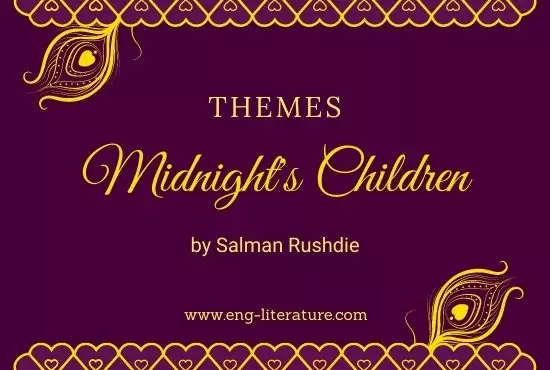Midnight’s Children Themes
Introduction
Rushdie’s novel Midnight’s Children has been interpreted in various ways. It is basically a work on history. But to read it only as a work of history is to miss the trees in the woods. There are several aspects to the novel. They include multiple identities, post-colonialism, post-modernism, magic realism, and in particular the quest for the meaning of life.
Theme of Multiple Identities
Although history is the predominant factor of the novel Rushdie creates Saleem with multiple identities. Saleem tries to resolve the crisis of his identity. The theme of multiple identities is portrayed in terms of many fathers of Saleem. His fathers include Methwold, Wee Willie Winkie and Ahmed Sinai. Similarly he has several mothers also. They include Amina, Mary and all the nannies.
Theme of problems of women
Women play a dominating part in Midnight’s Children in the shaping of the men. Marriage and sex for women are treated in terms of procreation. Saleem’s grandmother gives birth to twenty seven children within six years and commits suicide. Saleem’s mother Amina divorces her first husband just because she does not give birth to children. Thus the main concerns of the novelist are the problems of women such as loss of individuality and connecting their marriage and sex to man’s honour. The connection between marriage and social norms is responsible for the failure of marital relations. It is evident from the courtship and marriage of Saleem’s grand-parents (Naseem-Adam) and Saleem’s parents (Amina-Ahmed).
Theme of Magic Realism
The next theme of the novel is the technique of magic realism. Here magical elements appear in a realistic setting. It was originally used by a German art critic to describe painting which demonstrated an altered reality. It was later used to represent the work of certain Latin American writers. Afterwards, this technique is made use of by reputed novelists like Gunther Grass and Salman Rushdie. The essence of a magic realist novel is that fantastical elements take place but they never occur in reality. The characters accept the presence of magical elements. Magic and realism take place separately but at the same time they are incorporated together.
Also Read:
This technique enables the author to escape from the chaos of reality to an ideal world of order. The novel is a fabulated history that mixes fact with fantasy. The novelist makes use of fabulation, alteration, exaggeration and glorification as a narrative device to heighten the theme of socio-political, religious and cultural realities of the sub-continent. The actual history is portrayed as the back-drop while the foreground is delightfully fabulated. The dates and events in the novel are mostly recognizable so that the fantasy could be rooted in a specific reality.
Theme of Post-colonialism
The last but not the least theme presented in this novel is the aspect of post-colonialism. It is about dealing with the legacy of colonialism. Post-colonial literature deals with identity politics. The most important theme of post-colonial literature is national identity. The local writers began to write their own histories and legacy, Midnight’s Children is a post-colonial novel in two senses. The main narrative takes place after India becomes independent. Indian culture, religion and storytelling are presented here. This novel examines the effect of these indigenous and non-indigenous cultures on the Indian mind and in the light of Indian Independence.

Hello, Viewers! Besides being the Founder and Owner of this website, I am a Government Officer. As a hardcore literary lover, I am pursuing my dream by writing notes and articles related to Literature. Drop me a line anytime, whether it’s about any queries or demands or just to share your well-being. I’d love to hear from you. Thanks for stopping by!

Thanks for your service sir. Your work is more useful for rural and semi-urban students students who are doing PG English without so much language fluency in writing.
Sincerely welcome